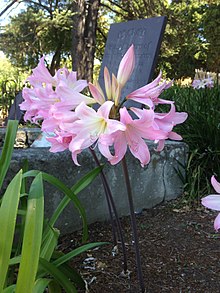
Back Amaryllis Afrikaans أمارلس Arabic امارلس ARZ Амарыліс Byelorussian Амарилис Bulgarian ऐमरिलिस Bihari Amarilis BS Amaril·lis Catalan Amaryllis CEB Amarylka Czech
| Amaryllis | |
|---|---|

| |
| Amaryllis belladonna | |
| Scientific classification | |
| Kingdom: | Plantae |
| Clade: | Tracheophytes |
| Clade: | Angiosperms |
| Clade: | Monocots |
| Order: | Asparagales |
| Family: | Amaryllidaceae |
| Subfamily: | Amaryllidoideae |
| Tribe: | Amaryllideae |
| Genus: | Amaryllis L. |
| Type species | |
| Amaryllis belladonna L.
| |
| Species | |
Amaryllis (/ˌæməˈrɪlɪs/)[1] is the only genus in the subtribe Amaryllidinae (tribe Amaryllideae). It is a small genus of flowering bulbs, with two species. The better known of the two, Amaryllis belladonna, is a native of the Western Cape region of South Africa, particularly the rocky southwest area between the Olifants River Valley and Knysna.[2]
For many years there was confusion among botanists over the generic names Amaryllis and Hippeastrum, one result of which is that the common name 'amaryllis' is mainly used for cultivars of the genus Hippeastrum, widely sold in the winter months for their ability to bloom indoors.
Plants of the genus Amaryllis are known as belladonna lily, Jersey lily, naked lady, amarillo, Easter lily in Southern Australia or, in South Africa, March lily due to its propensity to flower around March. This is one of numerous genera with the common name 'lily' due to their flower shape and growth habit. However, they are only distantly related to the true lily, Lilium. In the Victorian language of flowers, amaryllis means "love, beauty, and determination", and can also represent hope and achievement.[3]
- ^ Brenzel, Kathleen Norris (2001). The New Sunset Western Garden Book. Sunset Publishing. pp. 606–607.
- ^ "Amaryllis belladonna (March lily, Belladonna)". Biodiversity Explorer. Archived from the original on 2018-01-25. Retrieved February 2, 2020.
- ^ P., Rebekah (17 April 2020). "Amaryllis Flower Meaning and Symbolism". Florgeous. Retrieved 19 October 2020.